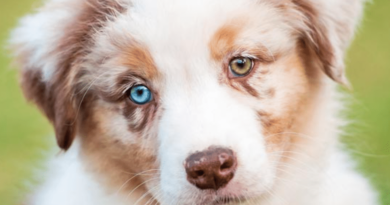What’s Normal Behavior Look Like in Small Puppies?
by Janice Jones |Last Updated 04-23-2021
Puppy behavior, although amusing, can often be puzzling to interpret
if you don’t understand their language.
Decoding those strange behaviors help one understand and bond with their
new puppy.
Dogs can not talk to let us know what they are thinking or feeling.
It is up to us to interpret their non verbal clues and body language.
You can learn to interpret any puppy behavior if you understand what they are trying to say to you through their actions.
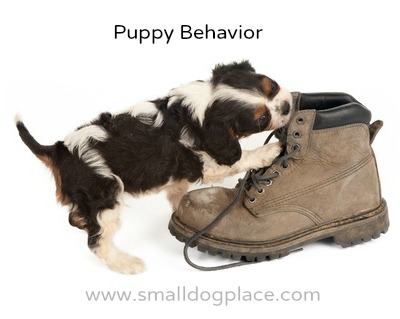
The Language of Small Puppies
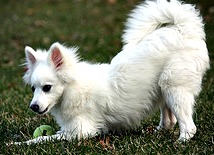 Play Bow: This puppy is ready to play
Play Bow: This puppy is ready to playPuppies and dogs do not share our sophisticated verbal language
but have ways of communicating with us through their body.
They use a set of signals that can convey meaning
to other dogs and to people if we learn how to interpret these signs. Dogs try to placate others with one set of
signals, avoid confrontation with another group of behaviors and use yet
another set of practices to calm themselves when stressed.
Many actions such as tail wagging can have
more than one meaning, so focusing strictly on the body language may not give
you the entire story.
Stressed Puppy Behavior
Many young puppies leave the breeder or pet shop around the age of eight weeks. It is unfortunate that eight weeks is the most popular time for puppies to leave the comfort and security of their mother and litter mates. At this age, they often develop and go through a fear stage.
Even confident dogs get stressed when placed in unfamiliar situations and will let you know just how uncomfortable they are by various actions.
If you happen to be holding your puppy and you suddenly feel him tightening his grip on you, hugging or clutching your arm tightly, you can be sure he is feeling stressed. He may also turn his head away from what is stressing him, preferring not to take a peak even. He may also turn his head away, yet keep an eye on the source of the stress, showing the whites of his eyes.
Shy puppies also have a habit of holding their tail between their legs rather than their usual position. If breed standards call for docked tails, you might not be able to notice this puppy behavior. A stressed or nervous dog may yawn to calm himself, a signal we may misinterpret because humans often yawn when they are fatigued.
Self-Calming Puppy Behaviors
Yawning is not the only method a puppy can use to calm
himself. Your puppy might show other
signs such as sneezing, licking his nose, spinning, or shaking off the
tension. If not cognizant to the body
language, many of these signs can go undetected, ignored or misunderstood.
Some
dogs might chase their tails as a way of distracting themselves from a
perceived stressful event.
Examples of Self-calming puppy behaviors
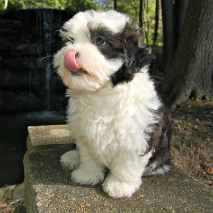 Licking lips Licking lips |
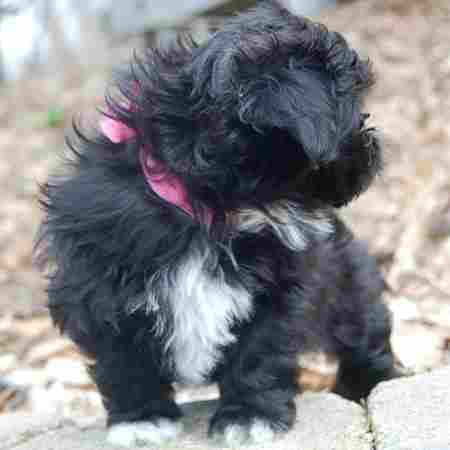 Turning away Turning away |
 Yawning Yawning |
Feeling Curious
Curious puppies often show behaviors that humans find
adorable.
Consider the little dog that
tilts his head to one side or another. Something novel has caught his attention,
and he is trying to make some sense of it.
They are tilting their head because
it puts an ear up and forward, helping them hear a little more clearly.
Dogs
that lift one front paw are waiting in anticipation for something to
happen. She may be waiting for a signal
from you to know what she should do next.
Feeling Excited
Dogs have many ways they show excitement. They may jump up, run in circles, bark or
yelp. Many will stop, roll over on their
backs in anticipation of a belly rub. Some dogs will urinate when excited, especially
if they are so excited that they just can’t hold it a second longer. This type of urination known as submissive urination has other meanings as
well.
Feeling Playful
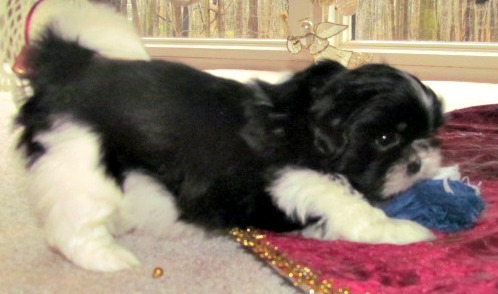 Playful Six-Week-Old-Puppy
Playful Six-Week-Old-PuppyYou will know your puppy wants to play when he is looking
relaxed, wagging his tail from side to side and blinking his eyes. A play bow, with his front legs flat on the
ground and his back legs standing upright holding his rear end high, is an
invitation to play.
This type of play
bow is used with their owner as well as with other dogs. Some dogs initiate play by rolling over on
the back inviting you to give them a belly rub.
A small jump forward and freeze tells you that they want to play, now.
Playful Puppy Behavior
Puppies just like human children learn about their
environment through exploration, experimentation and play. One favorite puppy
play game is fighting. This is always a very
energetic game that often results in loud yelps, growls, and barks.
Puppies take turns nipping at each other,
rolling around, jump and climbing on each other and having a great time. Their unsuspecting human might think there is
an actual war going on between them.
Very rarely does either puppy get hurt, but it does zap their energy, so
many will immediately fall into a deep sleep.
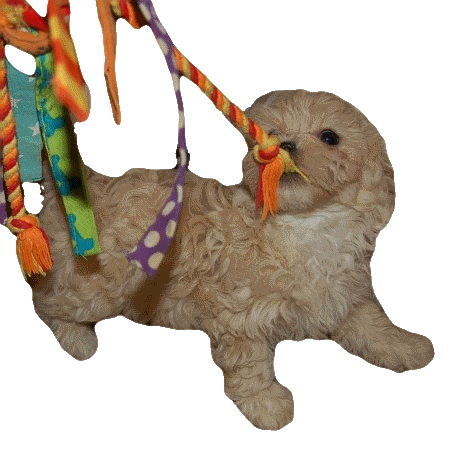 Tug of War Puppy Games Tug of War Puppy Games |
Another favorite game of puppies is tug of war. Litter mates will find anything to use as a This game is likely instinctual and a |
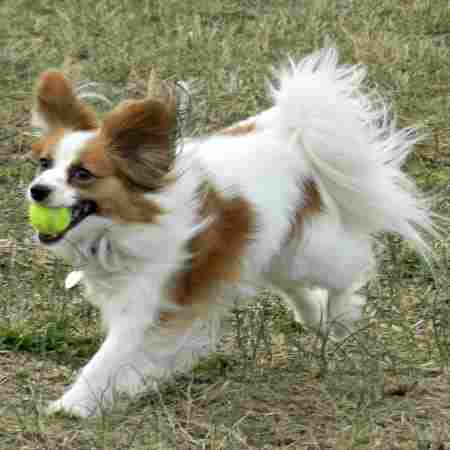 Playing Fetch Playing Fetch |
A great game of fetch is probably the game that comes to Small dogs that love this Playing nipping games with litter mates gradually teaches |
Progressively, they will adjust
their bite, so no one gets hurt. Puppies
taken away from siblings too early have a harder time learning to inhibit their
bite, a puppy behavior that most humans prefer to avoid.
Respect for Elders (Canine Elders)
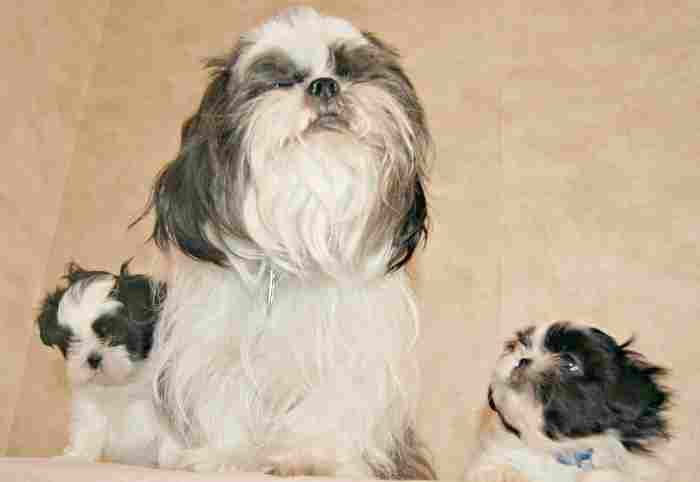 Learning to Respect older Dogs
Learning to Respect older DogsMany dogs learn from an early age that certain deferential
puppy behaviors will win the heart of an older, or larger dog. Most older, larger
dogs usually appear to empathize with little puppies and typically show little
aggression, probably because they see no threat in a tiny puppy.
Puppies learn from other dogs. They watch and imitate. This puppy behavior should be taken into consideration when a new dog is added to the family.
Puppies do have a way of endearing themselves
to their elders. They will jump up
towards the older dog’s face, licking and nuzzling at their face and
mouth. Some puppies will snuggle up
close to the older dog, roll over on their back as a sign of submission.
Smelly Security Blanket
All puppies (and adult dogs for that matter) like smelly
things—the smellier the better. This affinity for malodorous items usually comes as a surprise to many new puppy owners.
Did you ever wonder why some dogs love to sleep on your feet? It is unlikely they are looking for warmth. Rather, dogs love the smell of feet, and
anything associated with them—shoes, socks, and shoe laces.
Our feet have hundreds of thousands of sweat glands that
helps produce enough smells to keep even the smallest of puppies
interested. So the next time your dog
snuggles on your feet, thank him for keeping you warm, but know his motive is far
more self-serving than keeping your tootsies toasty.
Does This Article Deserve Your Thumbs Up?
We always appreciate your support and encouragement. Your thumbs up means so much to us. Please like this article.
If you find this page or any page on Small Dog Place Helpful, or Useful in anyway, I’d love it if you would click the small heart found on the bottom right of each page.
You can also share or bookmark this page — just click on the:

Free Monthly Newsletter
Sign Up for Our Free Newsletter and get our Free Gift to You.
my E-book, The Top 10 Mistakes People Make When Choosing a Dog (and how to avoid them)
If you enjoyed this page, I’d love it if you’d let me know. Just click the button below. Thank you.
Sharing is Caring




